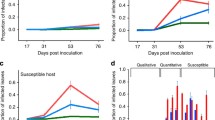Abstract
Populations of Phytophthora infestans have displaced less fit populations in a number of regions, but not in Scandinavia. In order to study this process, a simple epidemic model was developed, based on the Lotka-Volterra model for competition. The model contains two epidemics, each with logistic growth of two separate populations that interact with each other in that they compete for the same resource base (the plant). In Scandinavia, epidemics from suspected oospore infections are thought to start earlier than those originating from tubers, so routines were added to allow the epidemics to start at different time points. A numerical solution to the model was developed using the deSolve package of the open-source statistical program ‘R’. The resulting model allows examination of the relative importance of different values for the apparent infection rates and starting parameters for the two sub-epidemics. If epidemics from oospore infections start earlier than those from tuber infections, the delay for epidemic initiation via tuber infection would require extremely high values of r in order for this population to dominate at the end of the season. This could be one reason for the lack of persistent clones in the Scandinavian Phytophthora infestans population.




Similar content being viewed by others
References
Barrett, J. (1983). Estimating relative fitness in plant parasites: Some general problems. Phytopathology, 73(4), 510–512.
Brurberg, M. B., Elameen, A., Le, V. H., Naerstad, R., Hermansen, A., Lehtinen, A., Hannukkala, A., et al. (2011). Genetic analysis of Phytophthora infestans populations in the Nordic European countries reveals high genetic variability. Fungal Biology, 115, 335–342.
Fry, W. E., Goodwin, S. B., Dyer, A. T., Matuszak, J., Drenth, A., Tooley, P., et al. (1993). Historical and recent migrations of Phytophthora infestans: Chronology, pathways, and implications. Plant Disease, 653–661.
Fry, W. E., Grünwald, N. J., Cooke, D., McLeod, A., Forbes, G. A., & Cao, K. (2009). Population genetics and population diversity of Phytophthora infestans. In Oomycete genetics and genomics: Diversity, Interactions and research tools (p. 139). Wiley-Blackwell.
Gilligan, C. A. (1990). Antagonistic interactions involving plant pathogens: Fitting and analysis of models to non-monotonic curves for population and disease dynamics. New Phytologist, 115(4), 649–665.
Grönberg, L., Andersson, B., & Yuen, J. (2012). Weed hosts can increase aggressiveness of phytophthora infestans on potato. Phytopathology. doi:10.1094/PHYTO-12-11-0326.
Hannukkala, A. O., Kaukoranta, T., Lehtinen, A., & Rahkonen, A. (2007). Late-blight epidemics on potato in Finland, 1933–2002; increased and earlier occurrence of epidemics associated with climate change and lack of rotation. Plant Pathology, 56(1), 167–176.
Heesterbeek, J., & Zadoks, J. (1987). Modelling pandemics of quarantine pests and diseases: problems and perspectives. Crop Protection, 6(4), 211–221.
Kadish, D., & Cohen, Y. (1988). Competition between metalaxyl-sensitive and metalaxyl-resistant isolates of Phytophthora infestans in the absence of metalaxyl. Plant Pathology, 37(4), 558–564. doi:10.1111/j.1365-3059.1988.tb02115.x.
Kato, M., Mizubuti, E. S., Goodwin, S. B., & Fry, W. E. (1997). Sensitivity to protectant fungicides and pathogenic fitness of clonal lineages of Phytophthora infestans in the United States. Phytopathology, 87(9), 973–978.
Leach, J. E., Vera Cruz, C. M., Bai, J., & Leung, H. (2001). Pathogen fitness penalty as a predictor of durability of disease resistance genes. Annual Review of Phytopathology, 39(1), 187–224.
Leonard, K., & Czochor, R. (1980). Theory of genetic interactions among populations of plants and their pathogens. Annual Review of Phytopathology, 18(1), 237–258.
Milgroom, M., Levin, S., & Fry, W. (1989). Population genetics theory and fungicide resistance. In K. J. Leonard & W. E. Fry (Eds.), Plant disease epidemiology (Vol. 2, pp. 340–367). Mc Graw Hill Publishing Company.
Montarry, J., Andrivon, D. D., Glais, I., Corbiere, R., Mialdea, G., & Delmotte, F. (2010). Microsatellite markers reveal two admixed genetic groups and an ongoing displacement within the French population of the invasive plant pathogen Phytophthora infestans. Molecular Ecology, 19(9), 1965–1977.
Newton, M. R., Kinkel, L. L., & Leonard, K. J. (1997). Competition and density-dependent fitness in a plant parasitic fungus. Ecology, 78(6), 1774–1784.
O’Hara, R. B., & Brown, J. K. M. (1996). Immigration of the barley mildew pathogen into field plots of barley. Plant Pathology, 45(6), 1071–1076.
Skylakakis, G. (1980). Estimating parasitic fitness of plant pathogenic fungi: A theoretical contribution. Phytopathology, 70, 696–698.
Smart, C., & Fry, W. (2001). Invasions by the late blight pathogen: Renewed sex and enhanced fitness. Biological Invasions, 3(3), 235–243.
Tilman, D. (2007). Interspecific competition and multispecies coexistence. In R. May & A. McLean (Eds.), Theoretical ecology: Principles and applications (p. 84). USA: Oxford University Press.
van den Bosch, F., & Gilligan, C. A. (2008). Models of fungicide resistance dynamics. Annual Review of Phytopathology, 46, 123–147.
Vanderplank, J. (1963). Plant diseases: Epidemics and control. New York and London: Academic Press.
Weber, G. E., Gülec, S., & Kranz, J. (1994). Interactions between Erysiphe graminis and Septoria nodorum on wheat. Plant Pathology, 43(1), 158–163. doi:10.1111/j.1365-3059.1994.tb00565.x.
Widmark, A. K., Andersson, B., Cassel-Lundhagen, A., Sandström, M., & Yuen, J. E. (2007). Phytophthora infestans in a single field in southwest Sweden early in spring: Symptoms, spatial distribution and genotypic variation. Plant Pathology, 56(4), 573–579.
Author information
Authors and Affiliations
Corresponding author
Electronic Supplementary Material
Rights and permissions
About this article
Cite this article
Yuen, J.E. Modelling pathogen competition and displacement– Phytophthora infestans in Scandinavia. Eur J Plant Pathol 133, 25–32 (2012). https://doi.org/10.1007/s10658-011-9933-9
Accepted:
Published:
Issue Date:
DOI: https://doi.org/10.1007/s10658-011-9933-9




